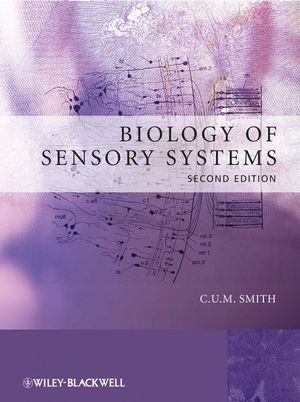
Biology of Sensory Systems
John Wiley & Sons Inc (Verlag)
978-0-470-51863-2 (ISBN)
- Titel z.Zt. nicht lieferbar
- Versandkostenfrei innerhalb Deutschlands
- Auch auf Rechnung
- Verfügbarkeit in der Filiale vor Ort prüfen
- Artikel merken
Written by a renowned author with extensive teaching experience, the book covers, in six parts, the general features of sensory systems, the mechanosenses, the chemosenses, the senses which detect electromagnetic radiation, other sensory systems including pain, thermosensitivity and some of the minority senses and, finally, provides an outline and discussion of philosophical implications.
New in this edition:
Greater emphasis on molecular biology and intracellular mechanisms
New chapter on genomics and sensory systems
Sections on TRP channels, synaptic transmission, evolution of nervous systems, arachnid mechanosensitive sensilla and photoreceptors, electroreception in the Monotremata, language and the FOXP2 gene, mirror neurons and the molecular biology of pain
Updated passages on human olfaction and gustation.
Over four hundred illustrations, boxes containing supplementary material and self-assessment questions and a full bibliography at the end of each part make Biology of Sensory Systems essential reading for undergraduate students of biology, zoology, animal physiology, neuroscience, anatomy and physiological psychology. The book is also suitable for postgraduate students in more specialised courses such as vision sciences, optometry, neurophysiology, neuropathology, developmental biology.
Praise from the reviews of the first edition:
"An excellent advanced undergraduate/postgraduate textbook." ASLIB BOOK GUIDE
"The emphasis on comparative biology and evolution is one of the distinguishing features of this self-contained book. .... this is an informative and thought-provoking text..." TIMES HIGHER EDUCATIONAL SUPPLEMENT
Dr. Christopher Upham Murray Smith. Honorary Visiting Fellow, Vision Sciences, Aston University, Birmingham, UK.
Preface to Second Edition. Preface to First Edition.
PART I: PRELIMINARIES.
Chapter 1 Elements.
1.1 Allosteric Effectors.
1.2 Membranes.
1.3 Membrane Signalling Systems.
1.4 Channels and Gates.
1.5 Concluding Remarks.
Chapter 2 Membranes, Action Potentials, Synapses.
2.1 The Measurement of Resting Potentials.
2.2 The Ionic Bases of Resting Potentials.
2.3 Electrotonic Potentials and Cable Conduction.
2.4 Receptor and Generator Potentials.
2.5 Sensory Adaptation.
2.6 Action Potentials.
2.7 Synapses and Synaptic Transmission.
2.8 Concluding Remarks.
Chapter 3 General Features of Sensory Systems.
3.1 Classification of the Senses.
3.2 Modality.
3.3 Intensity.
3.4 Adaptation.
3.5 Receptive Fields.
3.6 Maps of Sensory Surfaces.
3.7 Hierarchical and Parallel Design.
3.8 Feature Extraction and Trigger Stimuli.
3.9 Concluding Remarks.
Chapter 4 Classification and Phylogeny.
4.1 Systematics.
4.2 Classification into Six Kingdoms.
4.3 Unicellularity.
4.4 Multicellularity.
4.5 Protostomes and Deuterostomes.
4.6 Classification of the Metazoa.
4.7 Evolution of Nervous Systems.
4.8 Concluding Remarks.
Chapter 5 Genes, Genomics and Neurosensory Systems.
5.1 Introduction.
5.2 Comparative Genomics.
5.3 Genomes and Neurosensory Systems.
5.4 Concluding Remarks.
Part I: Self Assessment.
Part I: Notes, References and Bibliography.
PART II: MECHANOSENSITIVITY.
Chapter 6 Mechanosensitivity of Cell Membranes.
6.1 Mechanosensitive Channels in E. coli.
6.2 Detection of Osmotic Swelling by Hypothalamic Cells in Mammals.
6.3 Concluding Remarks.
Chapter 7 Kinaesthesia.
7.1 Kinaesthetic Mechanisms in Arthropods.
7.1.1 Stretch Receptors in Crustacean Muscle.
7.2 Kinaesthetic Mechanisms in Mammals.
7.3 Concluding Remarks.
Chapter 8 Touch.
8.1 Mechanoreception in Caenorhabditis Elegans.
8.2 Spiders.
8.3 Insects.
8.4 Tactile Receptors in Mammalian Skin.
8.5 Cerebral Analysis of Touch.
8.6 Plasticity of the Somaesthetic Cortex.
8.7 Concluding Remarks.
Chapter 9 Equilibrium and Hearing: The Uses of Hair Cells.
9.1 Anatomy and Physiology of Hair Cells.
9.2 Lateral Line Canals.
9.3 Evolution of the Vertebrate Ear.
9.4 Concluding Remarks.
Box 9.1 Biophysics of Outer Hair Cells.
Box 9.2 Genetics and Deafness.
Chapter 10 Cerebral Analysis.
10.1 The Mammalian Vestibular Pathway and Reflexes.
10.2 The Mammalian Auditory Pathway.
10.3 The Avian Auditory Pathway and the Mapping of Auditory Space by the Barn Owl.
10.4 The Mammalian Auditory Cortex.
10.5 The Bat Auditory System and Echolocation.
10.6 The Human Auditory Cortex and Language.
10.7 Lateralization and the Neuroanatomy of Language.
10.8 Language and the FOXP2 Gene.
10.9 Callosectomy and After.
10.10 Concluding Remarks.
Box 10.1 Broca and Wernicke.
Part II: Self Assessment.
Part II: Notes, References and Bibliography.
PART III: CHEMOSENSITIVITY.
Chapter 11 Chemosensitivity in Prokaryocytes.
11.1 Chemosentivity in E. coli.
11.2 Concluding Remarks.
Chapter 12 Mammalian Chemo- Enteroreceptors.
12.1 Location of Mammalian Chemoreceptors for PaO2 and PaCO2.
12.2 Structure.
12.3 Physiology.
12.4 Biochemistry.
12.5 Concluding Remarks.
Chapter 13 Gustation.
13.1 Gustation in Insects.
13.2 Gustation inMammals.
13.3 Concluding Remarks.
Chapter 14 Olfaction.
14.1 Insect Olfactory Systems.
14.2 Mammalian Olfactory Systems.
14.3 The Vertebrate Vomeronasal Organ (VNO) and Pheromones.
14.4 Concluding Remarks.
Part III: Self Assessment.
Part III: Notes, References and Bibliography.
PART IV: PHOTOSENSITIVITY.
Box I4.1 Bacteriorhodopsin.
Chapter 15 Invertebrate Vision.
15.1 Designs of Invertebrate Eyes.
15.2 Examples of Invertebrate Eyes.
15.3 Concluding Remarks.
Box 15.1 The Evolution of Opsins.
Box 15.2 Early Genetics of Eyes.
Chapter 16 The Human Eye.
16.1 Anatomy.
16.2 Embryology.
16.3 Detailed Anatomy and Physiology.
16.4 Movements of the Eyeball.
16.5 Concluding Remarks.
Box 16.1 Genetics of Cataract.
Chapter 17 The Retina.
17.1 Retinal Pigment Epithelium (RPE).
17.2 Retina.
17.3 Concluding Remarks.
Chapter 18 Visual Pathways and Cortices.
18.1 Visual Pathways into the Brain.
18.2 Primary Visual Cortex.
18.3 Extrastriate Cortices.
18.4 Face Recognition.
18.5 Prosopagnosia.
18.6 Concluding Remarks.
Box 18.1 The Reality of Cortical Columns.
Box 18.2 Blindsight.
Chapter 19 Other Vertebrate Visual Systems.
19.1 Visual Pigments.
19.2 Photoreceptors.
19.3 Tapeta.
19.4 Retinae.
19.5 Dioptric Apparatus.
19.6 Median Eyes.
19.7 Visual Pathways.
19.8 Visual Centres in the Brain.
19.9 Concluding Remarks.
Part IV: Self Assessment.
Part IV: Notes, References and Bibliography.
PART V: OTHER SENSES.
Chapter 20 Thermosensitivity.
20.1 Molecular Biology.
20.2 Poikilotherms.
20.3 Homeotherms.
20.4 Concluding Remarks.
Chapter 21 Minority Senses.
21.1 Infrared Radiation.
21.2 Polarized Light.
21.3 Electric Fields.
21.4 Magnetic Fields.
21.5 Concluding Remarks.
Chapter 22 Pain.
22.1 The Biological Significance of Pain.
22.2 Neurophysiology of Pain.
22.3 Neuropharmacology of Pain Pathways.
22.4 Referred Pain.
22.5 Gate Theory.
22.6 Concluding Remarks.
Part V: Self Assessment.
Part V: Notes, References and Bibliography.
PART VI: CODA.
Chapter 23 Summing Up.
23.1 Molecular Themes.
23.2 Cellular Themes.
23.3 Sense Organs.
23.4 Central Analysers.
23.5 Homeostasis.
23.6 Different Sensory Worlds.
23.7 From Abiotic to Biotic: Communication.
23.8 From Biotic to Social Communication: Mirror Neurons.
23.9 Concluding Remarks.
Chapter 24 Philosophical Postscript.
24.1 Descartes.
24.2 Qualia.
24.3 Tabula Rasa?
24.4 Epigenetic Epistemology.
24.5 Evolutionary Epistemology.
24.6 Beyond Descartes.
24.7 Concluding Remarks.
Part VI: Self Assessment.
Part VI: Notes, References and Bibliography.
Appendix: Some Techniques.
Acronyms and Abbreviations.
Glossary.
Index.
| Erscheint lt. Verlag | 9.2.2009 |
|---|---|
| Verlagsort | New York |
| Sprache | englisch |
| Maße | 189 x 245 mm |
| Gewicht | 1025 g |
| Themenwelt | Naturwissenschaften ► Biologie ► Humanbiologie |
| Naturwissenschaften ► Biologie ► Zoologie | |
| ISBN-10 | 0-470-51863-4 / 0470518634 |
| ISBN-13 | 978-0-470-51863-2 / 9780470518632 |
| Zustand | Neuware |
| Informationen gemäß Produktsicherheitsverordnung (GPSR) | |
| Haben Sie eine Frage zum Produkt? |
aus dem Bereich


